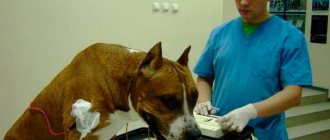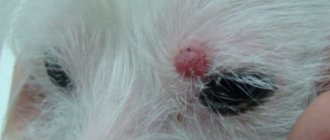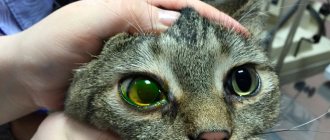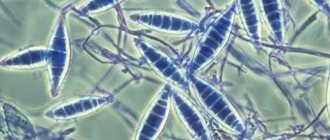What it is
The disease refers to inflammation of all layers of the skin. The development of the pathological process is provoked by blood-sucking parasites - fleas.
Features of the disease
Pathology develops when an allergic reaction occurs. It is provoked by flea saliva. It contains about fifteen allergens, each of which can lead to dermatitis.
Due to the entry of foreign components into the body, the immune system is activated. There is an active destruction of not only affected skin cells, but also healthy areas.
Life cycle of a flea
Fleas are wingless blood-sucking insects. Their development proceeds in several stages:
mature parasite;- egg;
- larva;
- doll
Under conditions suitable for life, the entire cycle takes about 2–3 weeks.
Adults live for 2 months. During this period, they manage to lay up to 2000 eggs.
Diagnostics
The doctor diagnoses “flea dermatitis” in more than half of the cats that their owners brought to see a dermatologist. What should the veterinarian do?
- examine the animal;
- interview the owners.
What a veterinarian does when examining a pet:
- The doctor most often rubs flea excrement on a dampened white paper or cloth; traces of blood, which are known to be red, help ensure that this is not ordinary dirt, but really blood.
- How do you look for fleas directly? Using a special comb. Another option that some experts resort to is to pre-treat the animal with a spray that contains a sealant. Nothing will happen to the animal. And all the parasites will die. And often even before the reception is over.
- Other parasitic dermatoses (for example: cheyletiellosis, lice, subcutaneous mites), as well as mycoses, are excluded.
- There is also a specific intradermal test. Once an allergen has been introduced, there may be an immediate reaction or a delayed reaction. The first is 10-20 minutes after administration, the second of these is 1-2 days.
- However, a positive answer in itself does not necessarily mean that the kitty has skin problems. This may mean that she simply has increased sensitivity to flea antigens.
- Thus, flea dermatitis is most often diagnosed if there is a parasitic infestation and if the veterinarian discovered it during an examination. But more often he uses trial therapy. Her goal: to prevent flea bites for at least 3 weeks.
Reference!
Fleas do not have to live in populations on the skin. They like to breed in warm conditions. For example, on a litter. This complicates an already difficult treatment.
How can you tell if a kitty has fleas?
There are several signs by which you can understand that your cat has fleas.
If a kitty just got fleas, they may not be visible to the naked eye; they sit deep in the undercoat. So far there is no cause for alarm.
Below we will list in what cases to worry and what to do.
- The cat begins to itch sharply and frequently, bites into its own skin, and wounds from scratching are visible on its body. If a cat behaves restlessly, you should closely monitor it, and if these behavior patterns do not stop, look for a pest. It will be a flea or a tick, depending on the situation.
- You need to put the kitty on a clean sheet of paper and comb it. If fleas have really “settled” on it, small black-brown crumbs should fall onto the paper - this is flea waste, namely feces. To make sure that this is really parasite excrement, drop water on these “crumbs” - it will turn red. Or brown-red.
- Finally, you can look for fleas directly on the cat's body. To do this, you need to take a comb with fine teeth and use it to push the fur apart, preferably not in one place, but in several.
- You may not be able to see the flea directly, but you will be able to detect the same excrement, which visually looks like black dust on the skin. But it's best to consult a veterinarian. He will name possible causes and recommend the necessary treatment.
- At the first alarming symptoms, delaying diagnosis is not the best option. Flea bites can literally drive her crazy and lead to neuroses. In addition, cat fleas do not disdain humans: they can settle on his body and bite.
What factors increase the risk of infection?
Flea dermatitis, like dermatosis, can develop in any animal. But there are a number of provoking factors, under the influence of which the risk of negative changes increases significantly.
Age
The puppy still has a rather weak immune system, unable to give a proper response to the irritant. Therefore, before the age of one year, pathology develops extremely rarely.
Also, the risk of such changes is minimal in older dogs: they already have time to develop antibodies that protect the body from substances secreted by insects.
It has been noted that animals aged from one to six years are more susceptible to the disease.
Breed
No pet is protected from this disease.
True, it is most often diagnosed in animals of the following breeds:
- Rottweiler;
- Labrador;
- bulldog;
- dachshund.
Gender
It cannot be said that in animals of the same sex the disease is observed more often. There are certain factors that increase the risk of the onset of the pathological process. For example, during pregnancy and lactation a dog is more susceptible to this disease.
Symptoms and types of disease
Fleas are most often found on the thighs, at the base of the tail. Allergic flea dermatitis appears in these places.
Symptoms and treatment of flea dermatitis in cats:
- Acute form. The animal is concerned about itchy skin and can injure the skin with its claws until it bleeds. Frequent licking.
- Subacute flea dermatitis. The disease manifests itself in an intermediate form.
- Chronic flea dermatitis. The animal's fur becomes less dense and sheds.
Diagnostics
Diagnosis of flea dermatitis begins with identifying the symptoms of the disease:
- constant itching;
- loss of appetite.
- vomiting, diarrhea;
- the skin dries out and scabs form;
- The animal meows often and behaves restlessly.
Even if it seems to you that your pet is not infested with insects, it is advisable to check this with a sheet of A4 paper. To do this, you need to wet it, put your pet on it and comb it properly with a brush.
What diseases can fleas carry?
External parasites carry very dangerous diseases . Both the pet and its owner can become infected with them.
Dipylidiasis
Tapeworms provoke the development of the disease. They settle in the gastrointestinal tract. Under favorable conditions, parasites can grow up to 75 cm in length.
Bacterial infection bartonellosis
The disease can lead to the development of a number of pathological processes.
Symptoms can be quite varied.
What happens if dermatitis is left unattended?
The condition poses a serious danger to the animal and negatively affects its general condition. If the pathology is severe, vomiting and nausea due to intoxication of the body are possible.
In addition, bacterial infection gets into the wounds. The result is purulent inflammatory processes.
When a pet's immunity is weakened, the risk of sepsis increases when purulent wounds form. If treatment is not started in a timely manner, death cannot be ruled out.
How to treat: an integrated approach to the problem
Therapy is carried out comprehensively. Several groups of drugs are used. Treatment with folk remedies is unacceptable. Otherwise, the dog's condition may worsen significantly.
Removal of parasites
First of all, you need to get rid of the parasites themselves. For this purpose, medications designed to combat fleas are used.
Special preparations
The following insecticides can be used to get rid of fleas:
Leopard;- Barrier;
- Frontline;
- Advantix.
How to apply flea control
Medicines against bloodsuckers are applied to the dog’s withers. In this area, the animal will not be able to lick the medicine.
It is also recommended to treat the pet’s habitat - enclosure, bedding, kennel.
Goal of symptomatic therapy
To eliminate the inflammatory process and get rid of itching, antihistamines are used.
Antiallergic drugs that block excessive histamine synthesis are also indicated.
When are antibiotics needed?
If abscesses, ulcers appear on the skin, or the pet becomes weak, antibiotics are prescribed. With their help, it is possible to destroy pathogenic microflora and avoid possible complications.
Treatment
Unfortunately, there is simply no single scheme that helps all animals in the difficult fight against flea dermatitis.
Usually, the veterinarian selects treatment on an individual basis. In the first stages, it is very important to rid the cat of hypersensitivity to flea saliva antigens. It is very necessary, it is vital to remove them, because, at their core, pests are the cause of flea dermatitis.
In order to destroy parasites, insecticidal preparations must be used. They can be bought and sold in veterinary pharmacies and are available in different forms: in the form of shampoos, drops that need to be dripped onto the withers, solutions, various aerosols. Kitty bedding must be processed (and ideally replaced with new ones).
The floor in the room is also treated with special anti-flea products. This measure helps to get rid of young [naturally, flea] individuals and prevent the animal from becoming infected again.
It is worth noting that veterinarians do not prescribe antihistamines for this type of dermatitis, due to their ineffectiveness. This disease is treated using medications such as glucocorticosteroids. The essence of such drugs is to reduce itching and inflammation, suppress the immune response to antigens.
These medications work within a few hours of use. Some drugs of this type are intended for internal use; they are prescribed for 7-10 days, after which their dosage is reduced.
Important!
At the same time, you need to know that, unfortunately, glucocorticosteroids often cause side effects. This also applies to the analogue of Prednisolone, which doctors use most often in veterinary practice.
To treat this disease, tablets called Capstar are also used. The medicine is intended for internal use. 30 minutes after it enters the cat’s body (more precisely, the stomach), the active components of the tablet penetrate the bloodstream and thereby destroy pests and soothe the animal’s skin.
Preventive actions
To prevent the development of dermatitis, you need to use a flea collar. It is also recommended to regularly treat the animal with drugs that destroy external parasites.
The treatment of animal habitats is of particular importance. Insecticides are used for this.
You also need to properly organize the animal’s regime and adhere to the rules of keeping it. The menu should be complete and balanced. The diet is enriched with vitamins and minerals.











